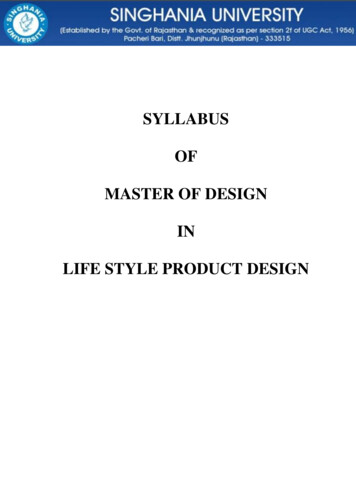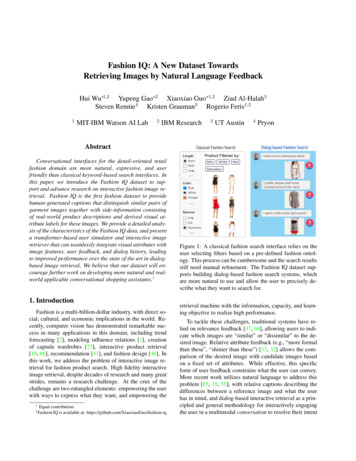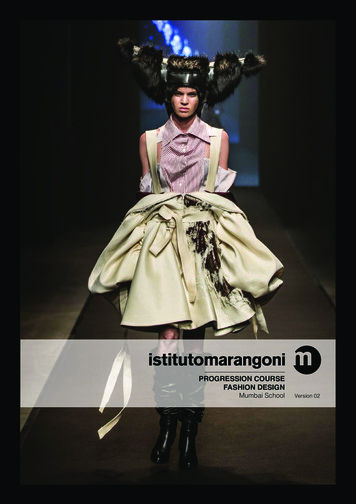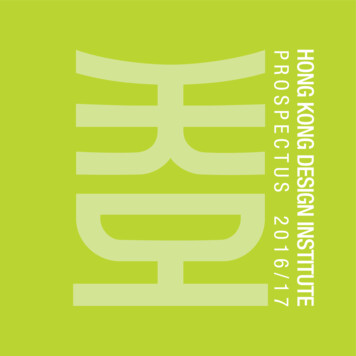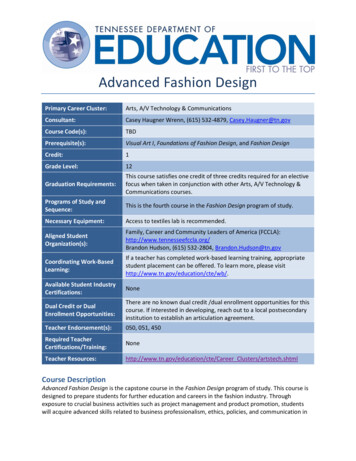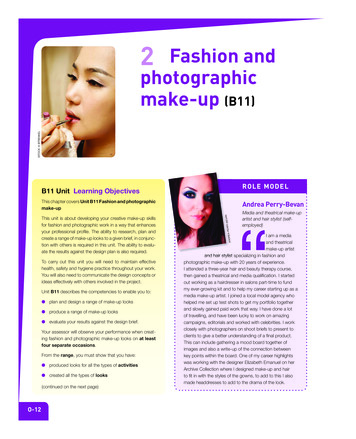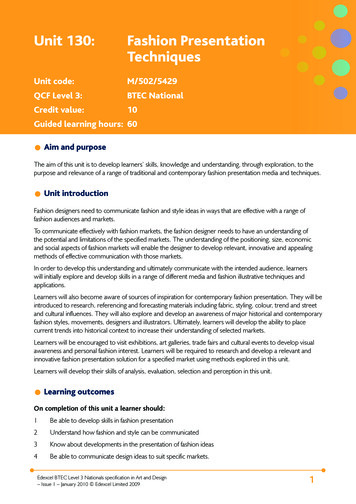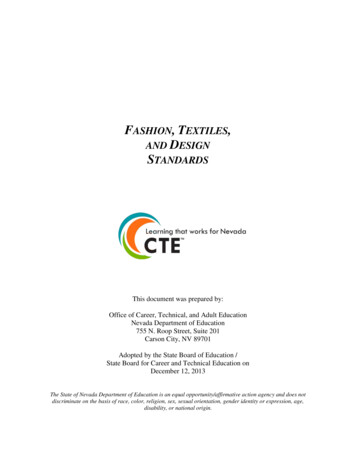
Transcription
FASHION, TEXTILES,AND DESIGNSTANDARDSThis document was prepared by:Office of Career, Technical, and Adult EducationNevada Department of Education755 N. Roop Street, Suite 201Carson City, NV 89701Adopted by the State Board of Education /State Board for Career and Technical Education onDecember 12, 2013The State of Nevada Department of Education is an equal opportunity/affirmative action agency and does notdiscriminate on the basis of race, color, religion, sex, sexual orientation, gender identity or expression, age,disability, or national origin.
FASHION, TEXTILES, AND DESIGN STANDARDS2013NEVADA STATE BOARD OF EDUCATIONNEVADA STATE BOARD FOR CAREER AND TECHNICAL EDUCATIONElaine Wynn. PresidentAllison Serafin .Vice PresidentThad Ballard. MemberDave Cook . MemberStavan Corbett . MemberAlexis Gonzales-Black. MemberFreeman Holbrook . MemberKevin Melcher . MemberMark Newburn . MemberRichard Stokes . MemberKamryn Mock . Student RepresentativeCTE MISSION STATEMENT:The Office of Career, Technical, and Adult Education is dedicated to developing innovativeeducational opportunities for students to acquire skills for productive employment and lifelong learning.NEVADA DEPARTMENT OF EDUCATIONDale A.R. ErquiagaSuperintendent of Public InstructionMichael J. Raponi, DirectorOffice of Career, Technical and Adult EducationReleased: 12/12/13Nevada CTE Standardsiii
FASHION, TEXTILES, AND DESIGN STANDARDS2013TABLE OF CONTENTSNevada State Board of Education / Nevada Department of Education. iiiAcknowledgements / Standards Development Members / Business and Industry Validation /Project Coordinator . viiIntroduction . ixContent Standard 1.0 – Career Exploration . 1Content Standard 2.0 – Design . 3Content Standard 3.0 – Textiles . 5Content Standard 4.0 – Construction . 6Content Standard 5.0 – Fashion Merchandising . 7Crosswalks and Alignments . 9Released: 12/12/13Nevada CTE Standardsv
FASHION, TEXTILES, AND DESIGN STANDARDS2013ACKNOWLEDGEMENTSThe development of Nevada career and technical standards and assessments is a collaborative effortsponsored by the Office of Career, Technical, and Adult Education at the Department of Education andthe Career and Technical Education Consortium of States. The Department of Education relies onteachers and industry representatives who have the technical expertise and teaching experience to developstandards and performance indicators that truly measure student skill attainment. Most important,however, is recognition of the time, expertise and great diligence provided by the writing team membersin developing the career and technical standards for Fashion, Textiles, and Design.STANDARDS DEVELOPMENT MEMBERSBeverley Davis, Owner/DesignerDesigns by Beverley, Las VegasMarcia Easterling, Community & EducationalAffairs, Fashion Institute of Design &Merchandising, Las VegasNancy Hamilton, CoordinatorCareer and Technical EducationClark County School District,Las VegasKatina McAmis, InstructorLas Vegas Academy of Performing Arts,Las VegasLucy Peters, InstructorSpanish Springs High School, SparksSheilah Petrosky, InstructorSouthwest Career and Technical Academy,Las VegasJasmine Reuel, InstructorCentennial High School, Las VegasDebra Salls, OwnerStar Costume, Las VegasShannon Sheldon, InstructorSouthwest Career and Technical Academy,Las VegasAlisa Sirat, InstructorSouthwest Career and Technical Academy,Las VegasCarolyn Thomas, Fashion Lead/InstructorInternational Academy of Design & Technology,Las VegasRobert Work, Fashion Designer & SubstituteTeacher, Clark County School District,Las VegasDennis Wright, Department Chair – DesignInternational Academy of Design & TechnologyLas VegasBUSINESS AND INDUSTRY VALIDATIONAll CTE standards developed through the Nevada Department of Education are validated by business andindustry through one or more of the following processes: (1) the standards are developed by a teamconsisting of business and industry representatives; or (2) a separate review panel was coordinated withindustry experts to ensure the standards include the proper content; or (3) the adoption of nationallyrecognized standards endorsed by business and industry.The Fashion, Textiles, and Design standards were validated through active participation of business andindustry representatives on the development team.PROJECT COORDINATORKaren Chessell, Education Programs ProfessionalFamily and Consumer Sciences, Education, Hospitality and Human ServicesOffice of Career, Technical and Adult EducationNevada Department of EducationReleased: 12/12/13Nevada CTE Standardsvii
FASHION, TEXTILES, AND DESIGN STANDARDS2013INTRODUCTIONThe standards in this document are designed to clearly state what the student should know and beable to do upon completion of an advanced high school Fashion, Textiles, and Design program. Thesestandards are designed for a three-credit course sequence that prepares the student for a technicalassessment directly aligned to the standards.These exit-level standards are designed for the student to complete all standards through theircompletion of a program of study. These standards are intended to guide curriculum objectives for aprogram of study.The standards are organized as follows:Content Standards are general statements that identify major areas of knowledge,understanding, and the skills students are expected to learn in key subject and career areas by the end ofthe program.Performance Standards follow each content standard. Performance standards identify the morespecific components of each content standard and define the expected abilities of students within eachcontent standard.Performance Indicators are very specific criteria statements for determining whether a studentmeets the performance standard. Performance indicators may also be used as learning outcomes, whichteachers can identify as they plan their program learning objectives.The crosswalk and alignment section of the document shows where the performance indicatorssupport the English Language Arts and the Mathematics Common Core State Standards, and the NevadaState Science Standards. Where correlation with an academic standard exists, students in the Fashion,Textiles, and Design program perform learning activities that support, either directly or indirectly,achievement of one or more Common Core State Standards.All students are encouraged to participate in the career and technical student organization (CTSO)that relates to their program area. CTSOs are co-curricular national associations that directly enforcelearning in the CTE classroom through curriculum resources, competitive events, and leadershipdevelopment. CTSOs provide students the ability to apply academic and technical knowledge, developcommunication and teamwork skills, and cultivate leadership skills to ensure college and career readiness.The Employability Skills for Career Readiness identify the “soft skills” needed to be successful inall careers, and must be taught as an integrated component of all CTE course sequences. These standardsare available in a separate document.The Standards Reference Code is only used to identify or align performance indicators listed inthe standards to daily lesson plans, curriculum documents, or national standards.Program NameFashion, Textiles, and DesignStandards Reference CodeFTDExample: FTD.2.3.4StandardsFashion, Textiles, and DesignReleased: 12/12/13Content Standard2Performance Standard3Nevada CTE StandardsPerformance Indicator4ix
FASHION, TEXTILES, AND DESIGN STANDARDSCONTENT STANDARD 1.0 :2013CAREER EXPLORATIONPERFORMANCE STANDARD 1.1 : ANALYZE THE ROLE OF PROFESSIONAL ORGANIZATIONS INFASHION, TEXTILE, AND APPAREL INDUSTRIES1.1.11.1.21.1.3Research historical trends of professional organizationsSummarize various professional support organizationsParticipate in a professional organization (e.g., FCCLA, DECA, FIDM Fashion Club, etc.)PERFORMANCE STANDARD 1.2 : ANALYZE OPPORTUNITIES FOR EMPLOYMENT ANDENTREPRENEURIAL .2.91.2.101.2.111.2.121.2.131.2.14Explore career opportunities in fashion, textile, and/or design industries, utilizing technologyDevelop job descriptions for fashion, textile, and/or design industriesAnalyze the future employment outlook in fashion, textile, and/or design industriesDevelop personal professional goalsPerform different jobs or tasks in fashion, textile, and design industriesDetermine preparation requirements for various levels of employment in a variety of fashion, textile,and/or design industriesDetermine how interests, abilities, personal priorities, and family responsibilities affect careerchoicesExplain the roles and functions of individuals engaged in textile and apparel careersDescribe entrepreneurial opportunities in fashion, textile, and/or design industriesExplain the characteristics of a successful entrepreneurIdentify the advantages and disadvantages of owning a businessIdentify the components of a business planResearch the legal requirements and resources needed for starting a businessApply the problem-solving process to resolve a business problemPERFORMANCE STANDARD 1.3 : SUMMARIZE EDUCATION AND TRAINING REQUIREMENTS FORCAREER OPPORTUNITIES1.3.11.3.21.3.3Utilize the internet to research and evaluate postsecondary educational programsParticipate in college fairs or campus visits, or consult a college recruiterDiscuss the postsecondary education application and financial aid processesReleased: 12/12/13Nevada CTE Standards1
2013FASHION, TEXTILES, AND DESIGN STANDARDSPERFORMANCE STANDARD 1.4 : ANALYZE THE EFFECTS OF TEXTILE AND APPAREL OCCUPATIONSON LOCAL, STATE, NATIONAL, AND GLOBAL ECONOMIES1.4.1 Differentiate between local, state, national, and global economies1.4.2 Research a period of economic growth or downsizing, and the impact on fashion, textile, and designoccupations1.4.3 Examine the effects of economics on fashion, textile, and/or design occupations1.4.4 Analyze the effects of internet business1.4.5 Anticipate the future impact of local, state, national, and global economies on fashion, textile, anddesign occupationsPERFORMANCE STANDARD 1.5 : CREATE A PROFESSIONAL PORTFOLIO1.5.11.5.21.5.31.5.41.5.52Organize a portfolio for the purpose of obtaining internships, work-based learning opportunities,postsecondary education, and employmentCompose a letter of intent, a cover letter, a letter of references, and a resumeIncorporate evidence of skill level in a portfolioImplement aesthetics and professionalism in a portfolioPrepare a digital portfolioNevada CTE StandardsReleased: 12/12/13
FASHION, TEXTILES, AND DESIGN STANDARDSCONTENT STANDARD 2.0 :2013DESIGN - DEMONSTRATE FASHION AND COSTUMEDESIGN SKILLSPERFORMANCE STANDARD 2.1 : UTILIZE ELEMENTS AND PRINCIPLES OF DESIGNING,CONSTRUCTING, AND/OR ALTERING END PRODUCTS2.1.12.1.22.1.3Apply the elements and principles of designRecognize and implement complex color schemes and color theory to develop and enhance visualeffectsExamine ways in which elements and principles of design can affect appearance, theme, and moodPERFORMANCE STANDARD 2.2 : USE PROPER ILLUSTRATION e the ability to draw the human figure (i.e., natural, fashion, and character)Identify a croquis and apply its useDemonstrate the proper use of tools and suppliesRecognize and implement a variety of mediums (e.g., markers, colored pencils, paint, etc.)Describe the sketching and illustration processUse sketches and illustrations to communicate ideasPERFORMANCE STANDARD 2.3 : DEVELOP DESIGN INSPIRATION2.3.12.3.22.3.32.3.42.3.5Research the history of clothing and fashionFollow trends in clothing and fashionDifferentiate between history, trends, and forecasting, and their applications in designDescribe sources of design and inspirationGenerate a design that reflects ecological, environmental, sociological, psychological, cultural,technical, and economic trends and issuesPERFORMANCE STANDARD 2.4 : DEMONSTRATE KNOWLEDGE OF DESIGN SKILLS2.4.12.4.22.4.32.4.42.4.52.4.6Evaluate a variety of aesthetics and points of viewDevelop a personal aesthetic and point of viewExplain the ways in which fabric characteristics affect designCreate multiple looks with a cohesive visionDemonstrate the ability to use technology for fashion, textile, and apparel designDemonstrate the ability to style a look using hair, makeup, accessories, and propsReleased: 12/12/13Nevada CTE Standards3
2013FASHION, TEXTILES, AND DESIGN STANDARDSPERFORMANCE STANDARD 2.5 : DEMONSTRATE DESIGN PRESENTATION SKILLS2.5.12.5.22.5.32.5.42.5.54Apply composition skills to a design presentationCreate samples to communicate the design visionIncorporate photography in the design presentationProvide and receive constructive criticismUtilize a portfolio to promote design skillsNevada CTE StandardsReleased: 12/12/13
FASHION, TEXTILES, AND DESIGN STANDARDSCONTENT STANDARD 3.0 :2013TEXTILES - ANALYZE FIBER AND FABRIC PRODUCTSAND MATERIALSPERFORMANCE STANDARD 3.1 : EVALUATE PERFORMANCE CHARACTERISTICS OF FIBERS,FABRICS, AND FINISHES3.1.13.1.23.1.33.1.4Classify fibers, yarns, and fabricsUtilize a magnifying device to examine the physical properties of fibers, yarns, and fabricsCompare and contrast performance characteristics of fibers, yarns, and fabricsAnalyze performance characteristics of fibers, yarns, and fabricsPERFORMANCE STANDARD 3.2 : EXAMINE PROCESSES FOR CREATING FIBERS, YARNS, ANDFABRICS3.2.13.2.23.2.33.2.43.2.5Compare and contrast natural and synthetic fibersProduce a woven, nonwoven, and knitted exampleExplain commercial production processes for creating fibers, yarns, woven, and knitted fabrics, andnonwoven textile productsAnalyze behaviors that conserve, reuse, and recycle resources to maintain the environmentDemonstrate the ability to repurpose existing garments and nontraditional materialsPERFORMANCE STANDARD 3.3 : ANALYZE THE EFFECTS OF TEXTILE CHARACTERISTICS ON THEDESIGN, CONSTRUCTION, CARE, USE, MAINTENANCE, ANDPRESERVATION OF PRODUCTS3.3.13.3.23.3.33.3.43.3.53.3.6Comprehend and follow product care labelsSelect appropriate fabric care productsDemonstrate appropriate fabric care procedures (i.e., stain removal, pressing, and storage)Demonstrate the safe use and care of a washing machine and dryerDifferentiate between wet and dry cleaning methodsDescribe the steps in textile preservation and storagePERFORMANCE STANDARD 3.4 : SUMMARIZE TEXTILE LEGISLATION, STANDARDS, AND LABELING3.4.13.4.23.4.3Utilize the internet to research textile legislation, standards, and labelingDescribe legislation affecting the textile industry and consumer protectionAnalyze legislation, regulations, and public policy affecting the fashion, textile, and apparelindustriesReleased: 12/12/13Nevada CTE Standards5
2013FASHION, TEXTILES, AND DESIGN STANDARDSCONTENT STANDARD 4.0 :CONSTRUCTION - DEMONSTRATE THE SKILLS NEEDEDTO PRODUCE, ALTER, AND REPAIR FASHION, TEXTILE,APPAREL, AND COSTUME PRODUCTSPERFORMANCE STANDARD 4.1 : DEMONSTRATE SKILLS USING INDUSTRY-STANDARD EQUIPMENT,TOOLS, NOTIONS, AND SUPPLIES4.1.14.1.24.1.34.1.44.1.54.1.6Demonstrate the safe use, care, and maintenance of a sewing machineDemonstrate the safe use, care, and maintenance of cutting, marking, pattern-making, and measuringtoolsDemonstrate the safe use, care, and maintenance of pressing, cleaning, and steaming equipmentDemonstrate the safe use, care, and maintenance of a serger and/or overlock machineDemonstrate the safe use, care, and maintenance of other specialized sewing equipmentApply notions using appropriate tools and equipmentPERFORMANCE STANDARD 4.2 : DEMONSTRATE THE SKILLS REQUIRED FOR PATTERN ANDFABRIC SELECTION AND 84.2.9Select patterns for a variety of projectsInterpret and apply information found on commercial patternsDetermine yardage requirements for a variety of projectsSelect appropriate fabrics and notions for a variety of projectsPrewash fabric, press, layout, pin, and cut a pattern, based on fabric characteristicsDemonstrate the ability to interpret and transfer pattern markingsDemonstrate the ability to alter a pattern for fitDemonstrate the ability to draft a patternDemonstrate the ability to drape on a dress formPERFORMANCE STANDARD 4.3 : DEMONSTRATE SKILLS FOR CONSTRUCTING, ALTERING, .84.3.94.3.106Demonstrate a variety of seams, seam finishes, and hemsDemonstrate various machine and hand-stitching techniquesDemonstrate appropriate pressing techniquesDemonstrate the application of various closuresDemonstrate the ability to construct a variety of garment features (e.g., collars, cuffs, pockets, etc.)Utilize software and/or online tutorials to assist in clothing constructionDemonstrate mending and repairing techniquesConstruct garments and products for a variety of end usesDemonstrate the ability to alter an existing garmentUtilize a variety of embellishment techniquesNevada CTE StandardsReleased: 12/12/13
FASHION, TEXTILES, AND DESIGN STANDARDSCONTENT STANDARD 5.0 :2013FASHION MERCHANDISINGPERFORMANCE STANDARD 5.1 : APPLY MARKETING STRATEGIES FOR FASHION, TEXTILE, ANDAPPAREL PRODUCTS5.1.15.1.25.1.35.1.45.1.55.1.6Utilize a spreadsheet to determine the costs of manufacturing and merchandising fashion productsIdentify ethical considerations for the manufacturing and merchandising of fashion productsDescribe the function and importance of quality controlDevelop an understanding of demographics as related to a target marketAnalyze basic components of textiles and their relationship to performanceDefine marketing, recognize marketing trends, and review marketing strategies for fashion productsPERFORMANCE STANDARD 5.2 : APPLY SKILLS AND KNOWLEDGE REQUIRED IN THE RETAILINDUSTRY5.2.15.2.25.2.35.2.45.2.5Investigate the day-to-day operations of a retail storeDescribe various methods of maintaining inventory controlEvaluate the use of technology in the retail environmentDifferentiate between design details in fashion, textile, and apparel products (e.g., sleeves, collars,skirt lengths, etc.)Classify various categories of merchandise (e.g., men’s wear, sportswear, petites, etc.)PERFORMANCE STANDARD 5.3 : ACQUIRE AN UNDERSTANDING OF SOURCING AND THEMERCHANDISE-BUYING PROCESS5.3.15.3.25.3.35.3.45.3.55.3.65.3.7Compare and contrast retail and wholesale practicesDescribe the importance of the sales report in determining the effectiveness of prior purchases andplanning future purchasesUtilize a spreadsheet to plan purchasesInvestigate the merchandise-buying processEvaluate a sales report to determine the effectiveness of a prior fashion seasonDetermine the effects of global trade in today’s retail environmentDevelop a marketing planPERFORMANCE STANDARD 5.4 : APPLY METHODS FOR PROMOTING TEXTILE AND Utilize and implement visual merchandisingDetermine external factors that influence merchandisingPractice methods for promoting textile and apparel productsAnalyze ethical considerations for merchandising textile and apparel productsApply marketing strategies for fashion, textile, or apparel productsForecast possible technological changes that impact the merchandising processCompare and contrast various promotion strategies for fashion productsReleased: 12/12/13Nevada CTE Standards7
2013FASHION, TEXTILES, AND DESIGN STANDARDSPERFORMANCE STANDARD 5.5 : IMPLEMENT RESEARCH METHODS, INCLUDING FORECASTINGTECHNIQUES, FOR MARKETING TEXTILE AND 5.5.85.5.9Forecast technological changes that impact the merchandising process (e.g., e-tailing, blogs,catalogues, etc.)Describe personal clothing needs and wants (i.e., wardrobe planning)Differentiate between physical, social, and psychological needsDescribe cultural, political, social, and economic factors that influence clothing choicesDescribe the stages in the fashion cycleDifferentiate between a classic and a fadDescribe the evolution of fashion through historyList influential designers throughout historyResearch and forecast trends in apparel marketingPERFORMANCE STANDARD 5.6 : EVALUATE THE COMPONENTS OF CUSTOMER SERVICE5.6.15.6.25.6.35.6.45.6.5Distinguish factors that contribute to quality customer relationsAnalyze the influences of cultural diversity as a factor in customer relationsCompare and contrast skill levels of quality customer serviceCreate solutions to address customer concerns (i.e., returns, exchanges, etc.)Investigate factors that influence consumer choices in purchasing decisionsPERFORMANCE STANDARD 5.7 : DEMONSTRATE GENERAL OPERATIONAL PROCEDURESREQUIRED FOR BUSINESS PROFITABILITY AND CAREER alyze legislation, regulations, and public policy affecting fashion, textile, and apparel industriesAnalyze personal and employer responsibilities and liabilities regarding industry-related safety,security, and environmental factorsAnalyze the effects of security and inventory control strategies, cash and credit transaction methods,laws, and worksite policies, on loss prevention and store profitDemonstrate procedures for reporting and handling accidents, safety, and security incidentsAnalyze operational costs such as markups, markdowns, cash flow, and other factors affecting profitDebate the ethics involved in the manufacturing and merchandising of fashion productsEstimate costs involved in the manufacturing and merchandising of fashion productsParticipate in tours of clothing manufacturers and merchandising facilitiesNevada CTE StandardsReleased: 12/12/13
FASHION, TEXTILES, AND DESIGN STANDARDS2013CROSSWALKS AND ALIGNMENTS OFFASHION, TEXTILES, AND DESIGN STANDARDSAND THE COMMON CORE STATE STANDARDS,THE NEVADA SCIENCE STANDARDS,AND THE COMMON CAREER TECHNICAL CORE STANDARDSCROSSWALKS (ACADEMIC STANDARDS)The crosswalk of the Fashion, Textiles, and Design Standards shows links to the Common Core StateStandards for English Language Arts and Mathematics and the Nevada Science Standards. Thecrosswalk identifies the performance indicators in which the learning objectives in the Fashion,Textiles, and Design program support academic learning. The performance indicators are groupedaccording to their content standard and are crosswalked to the English Language Arts andMathematics Common Core State Standards and the Nevada Science Standards.ALIGNMENTS (MATHEMATICAL PRACTICES)In addition to correlation with the Common Core Mathematics Content Standards, many performanceindicators support the Common Core Mathematical Practices. The following table illustrates thealignment of the Fashion, Textiles, and Design Standards Performance Indicators and the CommonCore Mathematical Practices. This alignment identifies the performance indicators in which thelearning objectives in the Fashion, Textiles, and Design program support academic learning.CROSSWALKS (COMMON CAREER TECHNICAL CORE)The crosswalk of the Fashion, Textiles, and Design Standards shows links to the Common CareerTechnical Core. The crosswalk identifies the performance indicators in which the learning objectivesin the Fashion, Textiles, and Design program support the Common Career Technical Core. TheCommon Career Technical Core defines what students should know and be able to do aftercompleting instruction in a program of study. The Fashion, Textiles, and Design Standards arecrosswalked to the Arts, A/V Technology & Communications Career Cluster and the Visual ArtsCareer Pathway.Released: 12/12/13Nevada CTE Standards9
2013FASHION, TEXTILES, AND DESIGN STANDARDSThis Page was Intentionally Left Blank10Nevada CTE StandardsReleased: 12/12/13
FASHION, TEXTILES, AND DESIGN STANDARDS2013CROSSWALK OF FASHION, TEXTILES, AND DESIGN STANDARDSAND THE COMMON CORE STATE STANDARDSCONTENT STANDARD 1.0: CAREER EXPLORATIONPerformanceIndicators1.1.1Common Core State Standards and Nevada Science StandardsEnglish Language Arts: Speaking and Listening StandardsSL.11-12.4Present information, findings, and supporting evidence, conveying a clear and distinctperspective, such that listeners can follow the line of reasoning, alternative or opposingperspectives are addressed, and the organization, development, substance, and style areappropriate to purpose, audience, and a range of formal and informal tasks.English Language Arts: Reading Standards for Literacy in Science and Technical SubjectsRST.11-12.7Integrate and evaluate multiple sources of information presented in diverse formats andmedia (e.g., quantitative data, video, multimedia) in order to address a question or solvea problem.English Language Arts: Writing Standards for Literacy in Science and Technical SubjectsWHST.11-12.8 Gather relevant information from multiple authoritative print and digital sources, usingadvanced searches effectively; assess the strengths and limitations of each source interms of the specific task, purpose, and audience; integrate information into the textselectively to maintain the flow of ideas, avoiding plagiarism and overreliance on anyone source and following a standard format for citation.1.1.2English Language Arts: Writing Standards for Literacy in Science and Technical SubjectsWHST.11-12.8 Gather relevant information from multiple authoritative print and digital sources, usingadvanced searches effectively; assess the strengths and limitations of each source interms of the specific task, purpose, and audience; integrate information into the textselectively to maintain the flow of ideas, avoiding plagiarism and overreliance on anyone source and following a standard format for citation.1.2.2English Language Arts: Writing Standards for Literacy in Science and Technical SubjectsWHST.11-12.7 Conduct short as well as more sustained research projects to answer a question(including a self-generated question) or solve a problem; narrow or broaden the inquirywhen appropriate; synthesize multiple sources on the subject, demonstratingunderstanding of the subject under investigation.1.2.3English Language Arts: Reading Standards for Literacy in Science and Technical SubjectsRST.11-12.9Synthesize information from a range of sources (e.g., texts, experiments, simulations)into a coherent understanding of a process, phenomenon, or concept, resolvingconflicting information when possible.1.2.5English Language Arts: Reading Standards for Literacy in Science and Technical SubjectsRST.11-12.3Follow precisely a complex multistep procedure when carrying out experiments, takingmeasurements, or performing technical tasks; analyze the specific results based onexplanations in the text.1.2.6English Language Arts: Reading Standards for Literacy in Science and Technical SubjectsRST.11-12.7Integrate and evaluate multiple sources of information presented in diverse formats andmedia (e.g., quantitative data, video, multimedia) in order to address a question or solvea problem.Released: 12/12/13Nevada CTE Standards11
20131.2.13FASHION, TEXTILES, AND DESIGN STANDARDSEnglish Language Arts: Reading Standards for Literacy in Science and Technical SubjectsRST.11-12.9Synthesize information from a range of sources (e.g., texts, experiments, simulations)into a coherent understanding of a process, phenomenon, or concept, resolvingconflicting information when possible.English Language Arts: Writing Standards for Literacy in Science and Technical SubjectsWHST.11-12.8 Gather relevant information from multiple authoritative print and digital sources, usingadvanced searches effectively; assess the strengths and limitations of each source interms of the specific task, purpose, and audience; integrate information into the textselectively to maintain the flow of ideas, avoiding plagiarism and overreliance on anyone source and following a standard format for citation.1.2.14English Language Arts: Reading Standards for Literacy in Science and Technical SubjectsRST.11-12.3Follow precisely a complex multistep procedure when carrying out experiments, takingmeasurements, or performing technical tasks; analyze the specific results based onexplanations in the text.1.3.3English Language Arts: Speaking and Listening StandardsSL.11-12.1aCome to discussions prepared, having read and researched material under study;explicitly draw on that preparation by referring to evidence from texts and otherresearch on the t
1.2.3 Analyze the future employment outlook in fashion, textile, and/or design industries 1.2.4 Develop personal professional goals 1.2.5 Perform different jobs or tasks in fashion, textile, and design industries 1.2.6 Determine preparation requirements for various levels of employment in a variety of fashion, textile, and/or design industries
